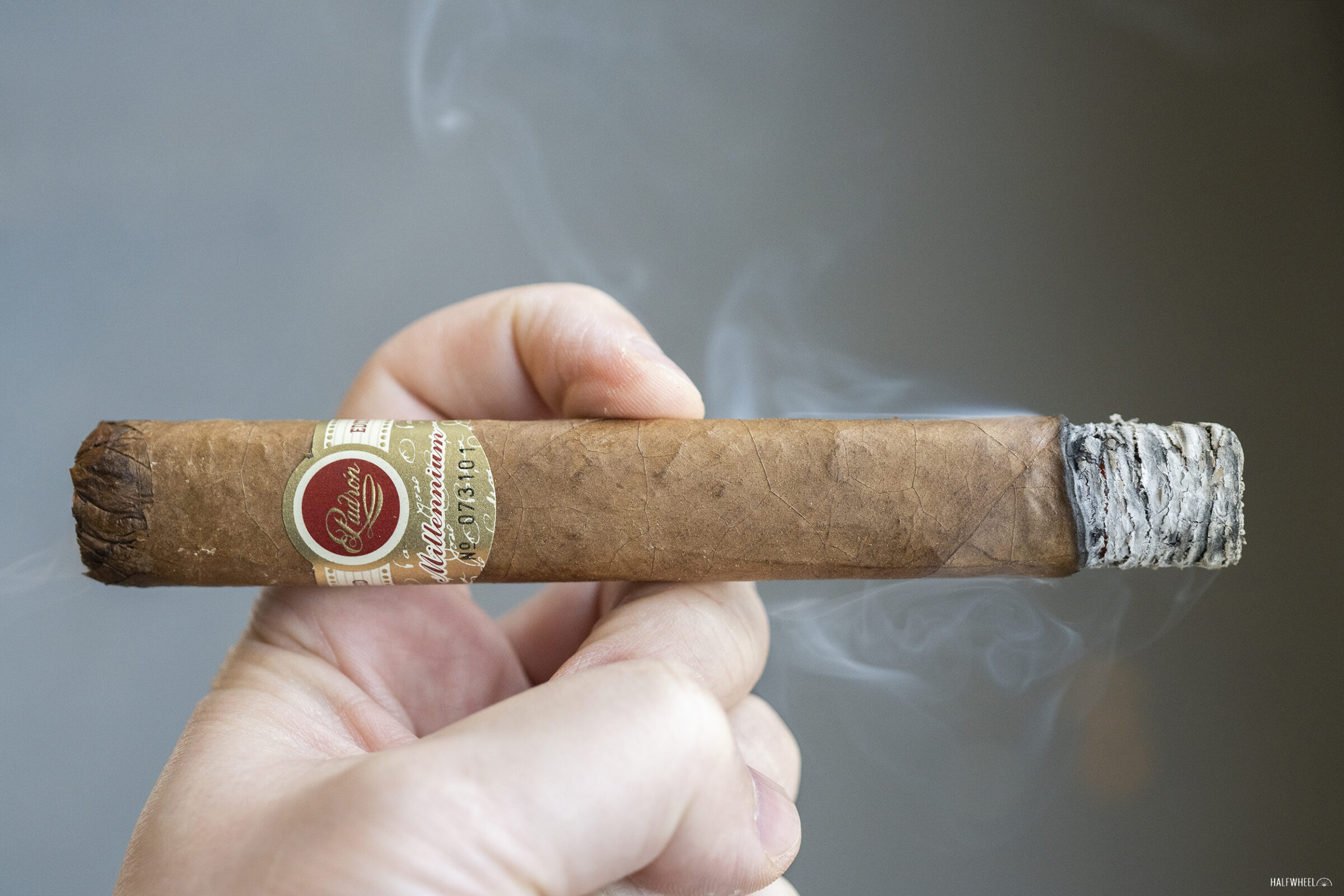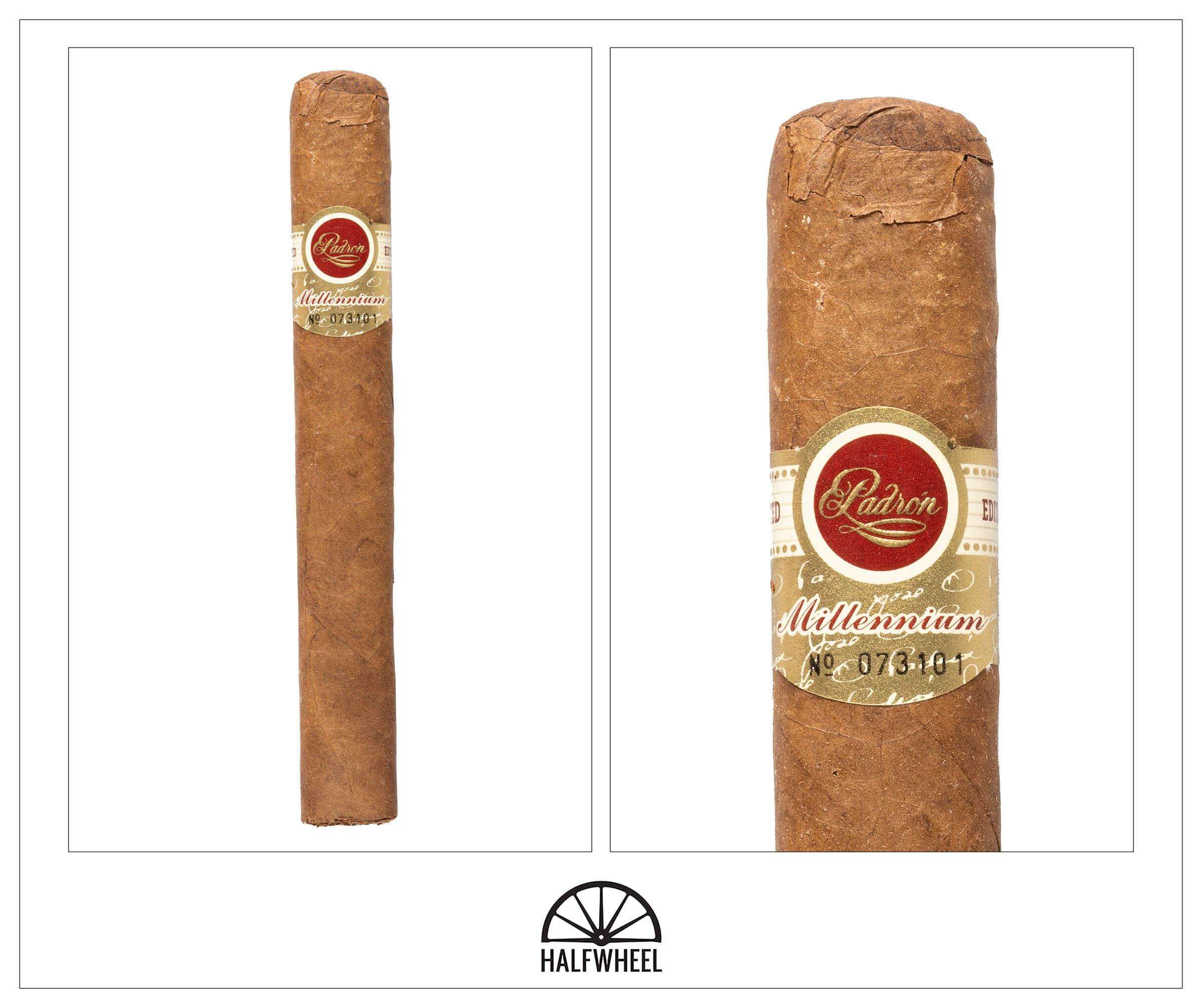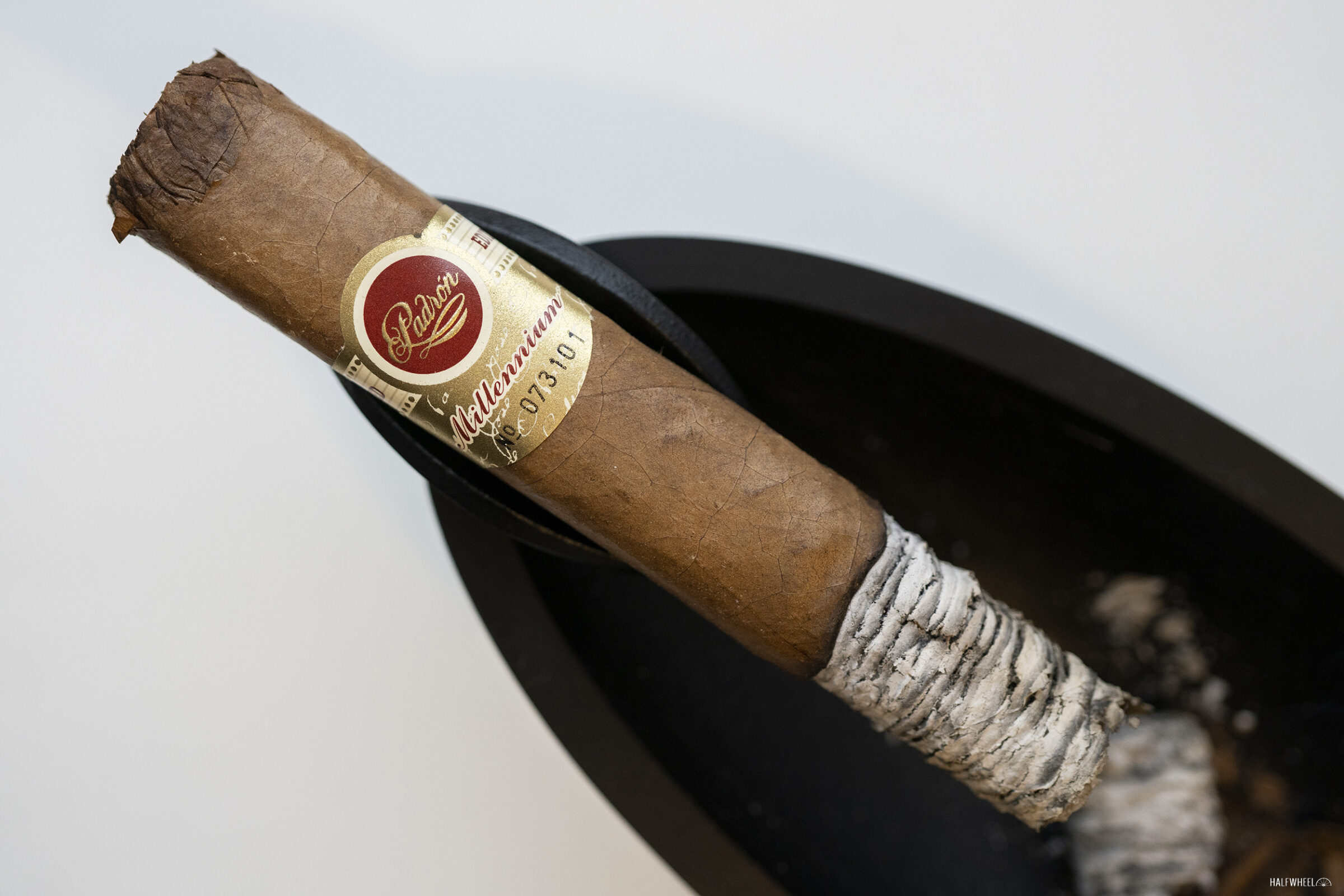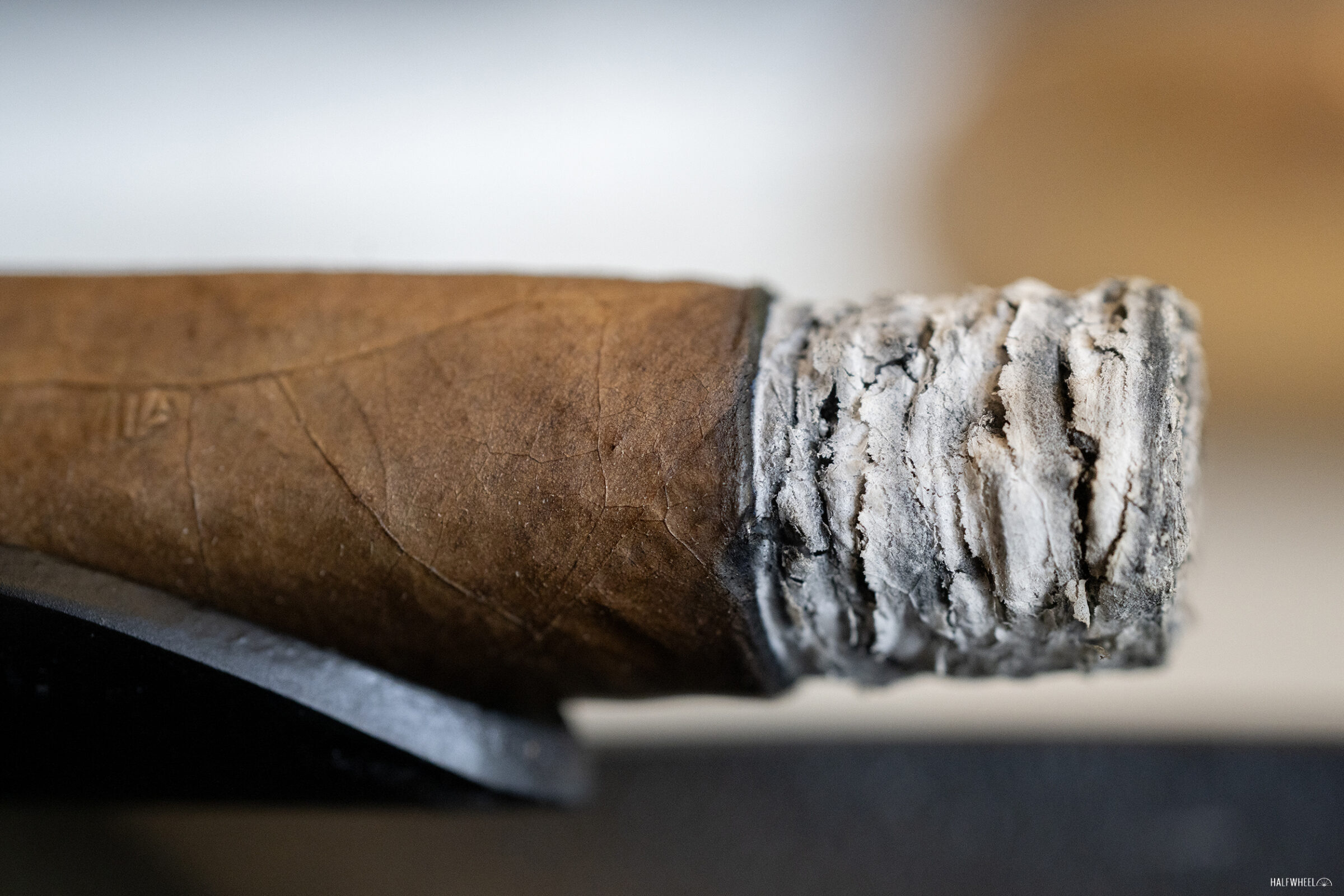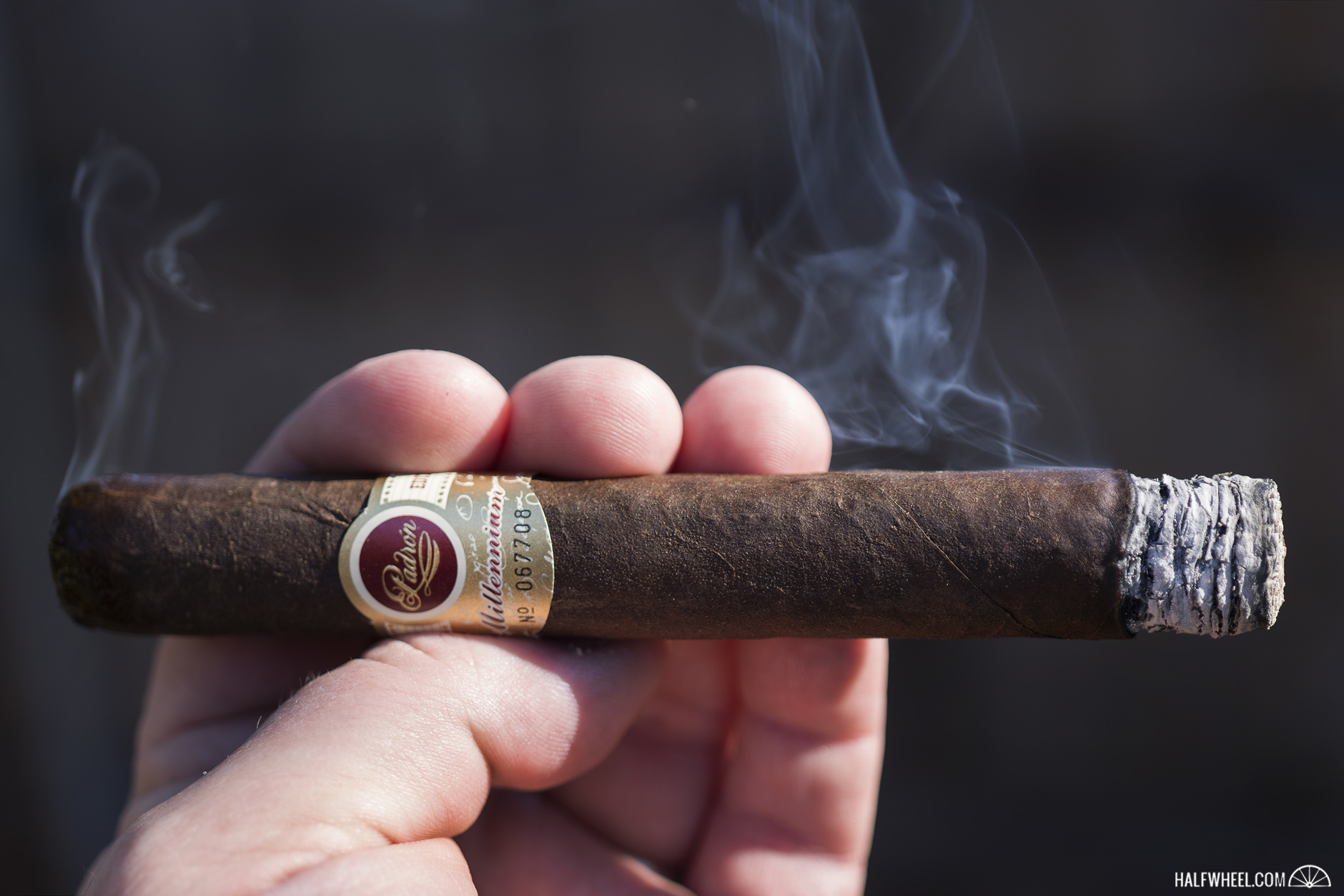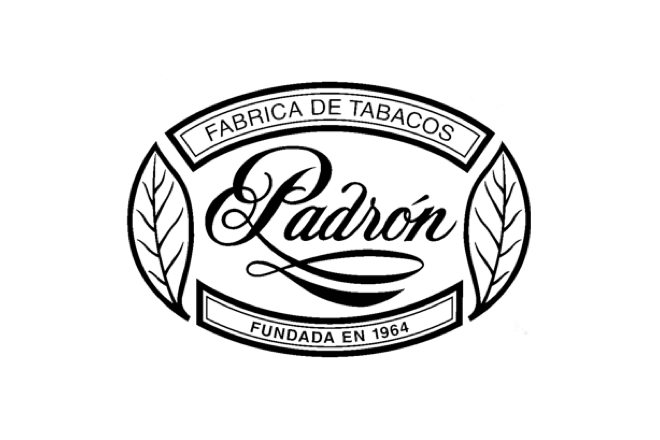In 1999, Padrón began rolling 100,000 cigars that were modified versions of its 1964 Anniversary Series. The cigars were made to be bolder, with the tobacco inside was aged for five years instead of the four-year aging that Padrón says it normally uses for the 1964 line.
They were rolled in preparation for the following year, 2000, the start of a new millennium.
The cigars were called Padrón Millennium and, like pretty much every other Padrón I can think of, offered in both Maduro and Natural wrapper options. Those 100,000 cigars were placed into 1,000 humidors, each containing 100 cigars.
Each cigar’s band got an individual serial number—a now well-established feature, but something that was new at the time—that would coincide to a particular humidor, meaning—assuming Padrón counted up—the cigar reviewed today should have come from humidor #732. The humidors themselves had five trays that each contained 20 cigars. The outside of the humidor had a bronze plate that let you know which humidor you got and the serial number range of the 100 cigars inside.
Here’s how a Padrón press release described the release:
To celebrate the Millennium, the Padrón family created the limited edition “Millennium 1964 Series.” Production was limited to 1,000 cases of 100 cigars each. The cigar, with dimensions of 52 x 6, is made with tobacco that has been aged for five years. All tobacco used for this single release was hand selected specifically for this limited production. Our goal was to blend a more full-bodied flavor while not compromising the balance that cigar connoisseurs have come to expect from our products.
Each cigar was priced at $25 and Padrón valued the humidor itself at $560, creating a total price of $3,060 per humidor.
In 2015, Padrón announced a small, second release of the Millennium known as Padrón Reserva Millennium. These cigars had been aging since the original release but would receive different packaging. This included bands that look more like the bottom band found on the 1964 and four-count boxes. Those cigars were sold to raise money for the new Instituto José O. Padrón, an Estelí, Nicaragua-based learning center that teaches English and computer skills to kids in Estelí.
Just 1,000 boxes of four were released as part of the Padrón Reserva Millennium.
- Cigar Reviewed: Padrón Millennium Natural
- Country of Origin: Nicaragua
- Factory: Tabacos Cubanica S.A.
- Wrapper: Nicaragua
- Binder: Nicaragua
- Filler: Nicaragua
- Length: 6 Inches
- Ring Gauge: 52
- Vitola: Toro Extra
- MSRP: $25 (Humidor of 100, $3,060; Price of Humidor $560)
- Release Date: 2000
- Number of Cigars Released: 1,000 Boxes of 100 Cigars (100,000 Total Cigars)*
- Number of Cigars Smoked For Review: 1
*This is the total Millenium release, including both Maduro and Natural wrappers.
Note: Since halfwheel launched in 2012, we have started off each new year with a week of reviews that are different from the other parts of the year. Rather than reviewing new cigars, we try to find cigars people might consider a holy grail cigar. These reviews are scored the same as our regular reviews, though oftentimes we are only able to procure one of the cigars, so many of these reviews are based on smoking one cigar instead of our normal three cigars per review. You can read more Holy Grail Week reviews by clicking here. — Charlie Minato.
If you swapped the band out for a normal Padrón band, I’d have no idea that this was nearly 25 years old. This particular cigar is one of the originals, noted by the solid gold band that says Millennium. The wrapper has a great sheen, consistent color and lots of veins. Despite its age, there’s still a decent amount of give and the press has remained remarkably intact with flat and even panels throughout the rectangular-shaped cigar. There is one loose seam and the cap is not the prettiest, but I’m more impressed by the wrapper itself: one of the most supple pieces of tobacco I’ve ever felt. Not surprisingly, the wrapper doesn’t smell like much. There’s some sort of aroma, but beyond the smell of old paper, I don’t get any standout scent. The foot is between mild and medium, with smells that remind me of stale bottled water and also some Spanish cedar. Cutting the cigar produces a cracking noise that concerns me, confirmed a split second later when I see that part of the cap has become dislodged. I hope that it’s done in a way that I can just tear off the dislodged part and not remove a full ring of tobacco, but it becomes clear that I’ll need to remove more tobacco than just the dislodged part. The cold draw has an open resistance with some more of the stale water and floral flavors. Subsequent cold draws see the sweet floral flavor get stronger while there’s some tahini that emerges underneath. Flavor-wise, it’s smooth with however many excessive o’s you want to add. Smooooooth.
The draw is a bit too open for the very first puff, so I don’t get as much smoke in the mouth as I’d like. What little smoke I do get brings a medium-full flavor of crispy nuttiness along with saltiness, woodiness and gingerbread flavors. Fortunately, subsequent puffs get the smoke production to an acceptable level, and my concerns about the draw are mostly alleviated. That said, after five or six puffs, there’s a major shift that results in a reduction of the rich savory flavor. In its place is a smoother nutty flavor that is nearly overwhelmed by a very smooth creaminess. It sort of reminds me of if you were to play a song at 1/10th speed: the sounds that are there would become drawn out, but because the song wasn’t designed to be played at that speed, there would be lots of moments when certain elements wouldn’t be heard because of the timing. What flavors I do get are smooth, but I wish there were a lot more flavors. Secondary notes include something that reminds me of Ruffles Sour Cream and Onion chips, bitter creaminess and blanched nuts. That plain nuttiness takes over during the finish, adding some generic sweetness but also bitterness. If there was an award for smoothest retrohale ever, this Padrón Millennium Natural wins it. There’s no irritation in the nose; instead, saltiness, nuttiness and more of the Ruffles Sour Cream and Onion flavor emerge. The retrohales are more compact than the main flavor, just slightly richer. The finish doesn’t have much different, with more saltiness and the addition of leather, but not a dynamic change. Flavor is medium-plus to medium-full, body is medium, and strength is mild. Construction is excellent, with the star of the show being a burn line that is so even it almost looks like it was painted on.
As the Padrón Millennium Natural nears the midway point, woodiness and the mildest amount of harshness enter the profile. It’s a tiny amount of harshness, so small that I’d probably not mention it during 99 percent of reviews, but because of how smooth the Padrón Millennium is, even the tiniest amount is noticeable. I don’t mind it, as it adds some extra dimension to a flavor profile that could use more notes. After the halfway mark, this aged tobacco flavor emerges and methodically builds to be the strongest flavor. It’s got some floral aspects to it, but it’s a distinctly different floral flavor than what I typically find. This is a flavor that I’ve tasted before, exclusively in cigars that have been aged for extensive periods of time. It’s inoffensive but not very interesting. The finish reminds me of some funky flour tortillas with peanuts, stale bottled water and some of the vintage tobacco flavor. Retrohales are similar: bitter creaminess, flour tortillas and the vintage tobacco flavor. Right around the halfway mark, I take a retrohale and find a finish that is a bit like beef jerky, joined by some mild paprika, but most retrohales are dominated by the floral and creamy flavors. Flavor is medium-full, body is medium and strength is mild. Construction remains excellent.
By the time I start to make notes about the final third, the Padrón Millennium Natural is overwhelmed by that vintage tobacco flavor. I’m entertained enough to keep smoking it, but my past experience tells me that this cigar is unlikely to change. That flavor gets stronger and stronger, drowning out most of the nuttiness and bitter creaminess that was there before. During occasional retrohales, I find some of the tahini flavors that surprised me early on, but they are fleeting in both frequency and intensity. As before, the vintage tobacco flavor typically overtakes each puff after just a few seconds, drowning out the complexity. Whatever harshness was present in the second third is largely absent in the final third, though the bitterness emerges at times. Flavor is medium-full to full, body is medium, and strength is non-existent. There comes a point when the cigar is going to need some help from the lighter to get the combustion back on track. I use that as my cue to call it a day.
Final Notes
- Padrón was not alone in celebrating the year 2000 with a Millennium cigar. CAO, Davidoff, Habanos S.A. and others made cigars called Millennium.
- If you’d like to see what the packaging looked like, click here or here.
- Unlike the Padrón 50th Anniversary Limited Edition Humidor release, there was no refill option with the Millennium. With the 50th Anniversary, consumers who purchased the humidor, as well as stores that sold the humidor, were given the option to order refill cigars. Padrón still makes those cigars, though the bands are different than the cigars that came with the humidor. In the case of the Millennium, you got what you got.
- One of Brooks Whittington’s first cigar reviews was of a Padrón Millennium Maduro. That review was published in November 2009 on SmokingStogie, one of the precursors to halfwheel.
- In that review, Brooks mentioned that he had heard that roughly 80 percent of the Millennium cigars were Maduro, meaning this Natural is far rarer. I suspect that was fodder taken from a cigar forum and probably not inside information Brooks had learned from Padrón. That said, with most Padrón releases, there are always more Maduros than Naturals. This not only includes limited editions but also product launches like, for example, the Padrón Family Reserve No. 85. Retailers will receive more boxes of Maduros than Naturals because the company makes more boxes of Maduros than Naturals.
- This cigar is an example of when many things can go right with the aging process, but the end result is still worse than had you smoked the cigar fresh. On one hand, the cigar’s construction was virtually flawless and there was a medium-full to full flavor profile. But the individual flavor sensations have mostly evaporated.
- Speaking of things going right, there are endless amounts of variables aging cigars this long, starting with having no idea whether the cigars themselves were any good to start with. The general belief seems to be that lower humidity levels are probably better for serious long-term aging, but I’m not sure anyone’s done any real studies about what works and doesn’t.
- My one personal observation that might seem counterintuitive is that I oftentimes find much more flavor left after 10+ years of aging from cigars that started more mild or medium than full. It’s not always true, but it probably has happened more often than not in my limited sample size.
- While I don’t think there’s a ton of value in scoring a Padrón Millenium after 24 years, there is one real value to reviews like this: honest context.
- If I were given the opportunity to drive a vintage Ferrari, I would probably tell you it was enthralling and one of the best cars I’ve ever driven. I have zero experience driving Ferraris, let alone vintage sports cars. So long as I didn’t crash it, I would likely have a blast, even if it was objectively a bad Ferrari. Too oftentimes, people don’t have the experience to properly judge something, are intimidated by the specialness to ever evaluate it honestly, do not care to offend, or some combination of the three. For some, saying you got to drive a vintage Ferrari might be more important than how the car drives.
- I’ve been lucky enough to smoke a lot of cigars in all different shapes and sizes, and can tell you that a 24-year-old Padrón Millennium is not an example of a good cigar. It’s not bad, but it’s definitely not a flavor profile I’d recommend other companies try to replicate. That said, if I smoked 10 cigars per year and a friend told me this was one of the most special non-Cuban cigars of all time, I probably wouldn’t have been able to make that same determination.
- What I can’t do is tell you whether this cigar was ever any good. I wasn’t (close to) old enough to smoke in 2000, so I never smoked one fresh. I’ve smoked at least one, maybe two, Padrón Millenniums before this one and the experience I remember is similar to this: aged too long.
- If you were to smoke a carbon copy of the cigar I smoked and loved it, I have great news for you. The flavors you are tasting aren’t exclusive to highly sought-after Padróns. These are flavors that I typically find in cigars, from different countries and factories, that have been aged for way too long. I’m not sure what the flavor is per se, but it seems that after a certain point, all cigar tobacco might taste the same.
- I don’t think it’s wrong if you like this profile. It’s way too mild and monotonous for me to enjoy, but it’s not some sort of assault on the palate. Unique, yes. But, I could understand someone liking this profile a lot more than a pepper bomb. This overly smooth profile has to be appealing to a wider audience in the same way Crown Royal is going to be drinkable to more of the population than Booker’s.
- Here’s a picture of the damage that was caused during cutting.
- In the first third, the burn line was even as I’ve ever seen on a cigar, almost like it was painted onto the cigar. The overall construction was truly incredible. I would have liked more smoke on the very first puff and the cigar wasn’t able to burn to the finger-burning nub area unless it got some help from a lighter, but for nearly three uninterrupted hours—the first puff to the last—it was basically as good as it gets.
- For quite some time, we’ve only reviewed cigars that we’ve purchased. This is an accidental exception to that rule. This particular cigar was gifted to me by a friend, someone who has never worked in the cigar industry, isn’t related to the Padróns, etc.
- Final smoking time was relatively quick for me, just under two hours.
I waited until Jan. 2 to smoke this cigar. By that point, we had already announced that this year is likely the end of Holy Grail Week reviews. As explained here, there are a number of reasons why, but this cigar is the example of the third point: The Futility of Reviewing & Scoring Cigars Past Their Primes. I’d venture to guess that most Padrón smokers would tell you that they don’t prefer to age their cigars. I subscribe to that theory. Furthermore, Jorge Padrón's philosophy is that the company should ship the cigars in a condition that they are ready to be enjoyed, not when they are ready to be aged. While I had an open mind that this cigar could have been excellent, I had already asked, out loud, what the point of reviewing a Padrón Millennium is in 2024. There was always a chance that this turned out excellent but that happening would have likely been an unintentional surprise, i.e., Padrón wasn’t intending to make a cigar that would be excellent after two decades. Presumably, it was trying to make a cigar that would be excellent in 2000. Padrón might have done that, but smoking it 24 years later isn't going to tell you. Our regular reviews tell you that it's difficult enough to make a cigar that consistently smokes well 90 days after it was rolled; producing a cigar that not only tastes good 90 days after it was rolled but also 9,000 days after it was rolled seems like the result of luck not skill. While I was surprised by how well this went, the useful advice is something that was already established before smoking this cigar: your Padróns will probably taste best when you buy them, and if you happen to like a Padrón after two decades of aging, it’s probably the case that you don’t really like Padrón, you like 20-year-old cigars.

